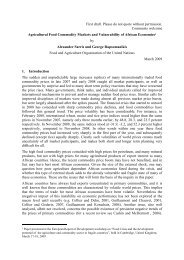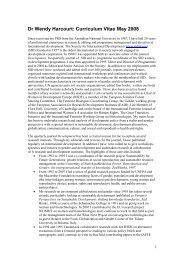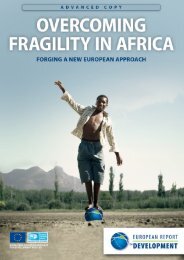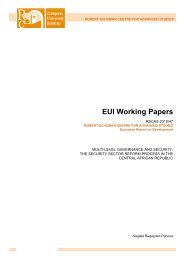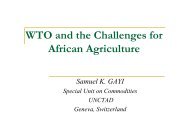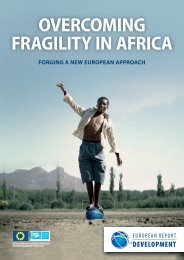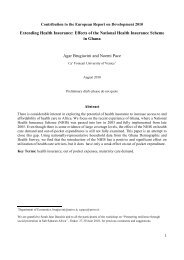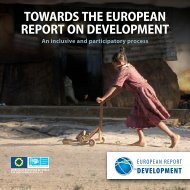formal and informal social protection in sub-saharan africa - ERD
formal and informal social protection in sub-saharan africa - ERD
formal and informal social protection in sub-saharan africa - ERD
Create successful ePaper yourself
Turn your PDF publications into a flip-book with our unique Google optimized e-Paper software.
FORMAL AND INFORMAL SOCIAL PROTECTIONIN SUB-SAHARAN AFRICAAbena D. Oduro , Department of Economics, University of Ghana, Legon, GhanaPaper prepared for the Workshop “Promot<strong>in</strong>g Resilience through Social Protection<strong>in</strong> Sub-Saharan Africa” organised by the European Report on Development <strong>in</strong> Dakar,28-30 June 2010Mobilis<strong>in</strong>g European ResearchFOR Development Policies
BUILDING SOCIAL PROTECTION SYSTEMS IN SOUTHERN AFRICAAbstractThis paper assesses developments <strong>in</strong> the provision of <strong>formal</strong> <strong>social</strong> <strong>protection</strong> <strong>in</strong> Africa. Formal <strong>social</strong> <strong>protection</strong> is def<strong>in</strong>ed to<strong>in</strong>clude actions taken by the public sector (alone or <strong>in</strong> conjunction with other parties such as non-governmental organisations<strong>and</strong> donors) <strong>and</strong> private sector arrangements that have legal back<strong>in</strong>g. The focus of the discussion will be on the provisionof <strong>formal</strong> <strong>social</strong> <strong>protection</strong> by the state. Social <strong>protection</strong> <strong>in</strong> many African countries is not new. The development of <strong>formal</strong><strong>social</strong> <strong>protection</strong> <strong>in</strong> several of these countries can be del<strong>in</strong>eated <strong>in</strong>to three phases. The paper also considers what the effectof a scal<strong>in</strong>g up of <strong>formal</strong> <strong>social</strong> <strong>protection</strong> will have on <strong>in</strong><strong>formal</strong> <strong>social</strong> <strong>protection</strong> arrangements. In<strong>formal</strong> <strong>social</strong> <strong>protection</strong>encompasses those arrangements <strong>and</strong> actions taken by an <strong>in</strong>dividual or by groups of <strong>in</strong>dividuals which are not guided by<strong>formal</strong> legal regulations, but which are not necessarily contraven<strong>in</strong>g these laws <strong>and</strong> regulations.Abena D. OduroDepartment of Economics, University of Ghana, Legon, Ghanae-mail: abena.oduro@gmail.comThe views expressed <strong>in</strong> this paper are those of the authors, <strong>and</strong> should not be taken to be the views ofthe European Report on Development, of the European Commission or of the European Union Member States.2
FORMAL AND INFORMAL SOCIAL PROTECTION IN SUB-SAHARAN AFRICAIntroductionSeveral def<strong>in</strong>itions <strong>and</strong> conceptualisations of <strong>social</strong> <strong>protection</strong> abound. The World Bank <strong>in</strong> its2001 paper on develop<strong>in</strong>g a <strong>social</strong> <strong>protection</strong> strategy for Africa def<strong>in</strong>es <strong>social</strong> <strong>protection</strong> as:“<strong>in</strong>terventions that assist poor <strong>in</strong>dividuals, households <strong>and</strong> communities to reduce theirvulnerability by manag<strong>in</strong>g risks better” (p 4).In the first poverty reduction strategy paper of Mali, a similar conceptualisation of <strong>social</strong><strong>protection</strong> was adopted <strong>in</strong> which <strong>social</strong> <strong>protection</strong> was presented as “a collective system formanag<strong>in</strong>g risks faced by <strong>in</strong>dividuals” (Government of Mali, 2002). Dfid takes a broaderperspective. Social <strong>protection</strong> is def<strong>in</strong>ed as:“public actions – carried out by the state or privately – that: a) enable people to dealmore effectively with risk <strong>and</strong> their vulnerability to crises <strong>and</strong> changes <strong>in</strong>circumstances (such as unemployment or old age); <strong>and</strong> b) help tackle extreme <strong>and</strong>chronic poverty” (Dfid 2006 p. 1).Other African countries take a similar broad perspective. Ben<strong>in</strong>, <strong>in</strong> its poverty reductionstrategy paper of 2003, states that:“<strong>social</strong> <strong>protection</strong> comprises all systems <strong>and</strong> measures that provide <strong>social</strong> assistance<strong>and</strong> various <strong>social</strong> services to the different <strong>social</strong> <strong>and</strong> professional groups” (Republic ofBen<strong>in</strong>, 2002).In Tanzania’s National Social Protection Framework document, <strong>social</strong> <strong>protection</strong> is def<strong>in</strong>edas:“traditional family <strong>and</strong> community support structures, <strong>and</strong> <strong>in</strong>terventions by state <strong>and</strong>non-state actors that support <strong>in</strong>dividuals, households <strong>and</strong> communities to prevent,manage, <strong>and</strong> overcome the risks threaten<strong>in</strong>g their present <strong>and</strong> future security <strong>and</strong>well-be<strong>in</strong>g, <strong>and</strong> to embrace opportunities for their development <strong>and</strong> for <strong>social</strong> <strong>and</strong>economic progress <strong>in</strong> Tanzania” (United Republic of Tanzania, 2008, p. 5).In the <strong>social</strong> policy framework document prepared by the African Union,“<strong>in</strong>terventions under a <strong>social</strong> <strong>protection</strong> framework <strong>in</strong>clude <strong>social</strong> security measures<strong>and</strong> further<strong>in</strong>g <strong>in</strong>come security; <strong>and</strong> also the pursuit of an <strong>in</strong>tegrated policy approachthat has a strong developmental focus, such as job creation, equitable <strong>and</strong> accessiblehealth <strong>and</strong> other services, <strong>social</strong> welfare, quality education <strong>and</strong> so on” (African Union,2008, p.17).Countries, households <strong>and</strong> <strong>in</strong>dividuals <strong>in</strong> Africa have to deal with the <strong>in</strong>stability of the globaleconomy, conflict, disease, the vagaries of the weather <strong>and</strong> climate change. Vulnerability topoverty is high. Households that are not classified as be<strong>in</strong>g poor at a po<strong>in</strong>t <strong>in</strong> time have ahigh probability of becom<strong>in</strong>g poor <strong>in</strong> the future. In Ghana, even though the povertyheadcount was 39.5% <strong>in</strong> 1998/99, it was estimated that the <strong>in</strong>cidence of vulnerability topoverty was 49.5% (Appiah-Kubi et al, 2008). The focus of <strong>social</strong> <strong>protection</strong> must extendbeyond better management of risks <strong>in</strong> order to <strong>in</strong>clude those <strong>in</strong>dividuals <strong>and</strong> groups whohave difficulty <strong>in</strong> mak<strong>in</strong>g ends meet from one day to the next, not because of exposure tonegative shocks but because they are old, or have disabilities, or have slipped <strong>in</strong>to povertybecause of lost opportunities or because of <strong>social</strong> <strong>in</strong>equalities that result <strong>in</strong> them be<strong>in</strong>glocked <strong>in</strong>to exploitative relationships.Devereux <strong>and</strong> Sabates-Wheeler (2004) conceptualise <strong>social</strong> <strong>protection</strong> as hav<strong>in</strong>g fourdimensions. It must conta<strong>in</strong> preventive measures that help to manage shocks, for example,pensions <strong>and</strong> health <strong>in</strong>surance. Second, the <strong>social</strong> <strong>protection</strong> strategy should have aprotective element. This would <strong>in</strong>volve the provision of assistance to those who are unable3
FORMAL AND INFORMAL SOCIAL PROTECTION IN SUB-SAHARAN AFRICAto work <strong>and</strong> the provision of <strong>social</strong> services to targeted groups such as orphans <strong>and</strong>ab<strong>and</strong>oned children. The third dimension is measures to promote <strong>in</strong>come-generation <strong>and</strong>capabilities. Under this head<strong>in</strong>g would fall the provision of <strong>sub</strong>sidised <strong>in</strong>puts, micro-f<strong>in</strong>ance<strong>and</strong> school-feed<strong>in</strong>g programmes. The fourth dimension is transformative measures which“seek to address concerns of <strong>social</strong> equity <strong>and</strong> exclusion…” (p. 10). This is a very broadconceptualisation of <strong>social</strong> <strong>protection</strong> that extends beyond the realm of risk management toembrace <strong>in</strong>come generation <strong>and</strong> changes <strong>in</strong> the legal <strong>and</strong> regulatory frameworks. Theadvantage of this conceptualisation of <strong>social</strong> <strong>protection</strong> is that it br<strong>in</strong>gs with<strong>in</strong> its ambit thevarious categories of the poor, the excluded <strong>and</strong> the vulnerable. The disadvantage of this,however, is that the l<strong>in</strong>e between <strong>social</strong> <strong>protection</strong> <strong>and</strong> the overall development strategy ofa country can become quite blurred.The objective of this paper is to assess developments <strong>in</strong> the provision of <strong>formal</strong> <strong>social</strong><strong>protection</strong> <strong>in</strong> Africa. Formal <strong>social</strong> <strong>protection</strong> is def<strong>in</strong>ed <strong>in</strong> this paper to <strong>in</strong>clude actions takenby the public sector (alone or <strong>in</strong> conjunction with other parties such as non-governmentalorganisations <strong>and</strong> donors) <strong>and</strong> private sector arrangements that have legal back<strong>in</strong>g. Thefocus of the discussion will be on the provision of <strong>formal</strong> <strong>social</strong> <strong>protection</strong> by the state. Asecond objective of the paper is to consider what the effect of a scal<strong>in</strong>g up of <strong>formal</strong> <strong>social</strong><strong>protection</strong> will have on <strong>in</strong><strong>formal</strong> <strong>social</strong> <strong>protection</strong> arrangements. In<strong>formal</strong> <strong>social</strong> <strong>protection</strong>encompasses those arrangements <strong>and</strong> actions taken by an <strong>in</strong>dividual or groups of<strong>in</strong>dividuals which are not guided by <strong>formal</strong> legal regulations, but which are not necessarilycontraven<strong>in</strong>g these laws <strong>and</strong> regulations. Dfid, for example, def<strong>in</strong>es <strong>in</strong><strong>formal</strong> <strong>protection</strong> as“either actions to m<strong>in</strong>imise risks or transfers between <strong>in</strong>dividuals or households to copedur<strong>in</strong>g difficult times” (Dfid 2006, p. 6).Social <strong>protection</strong> <strong>in</strong> many African countries is not new. This paper argues that thedevelopment of <strong>formal</strong> <strong>social</strong> <strong>protection</strong> <strong>in</strong> several of these countries can be del<strong>in</strong>eated <strong>in</strong>tothree phases. Even though poverty reduction strategy papers may be described as aconditionality of the enhanced HIPC (Heavily Indebted Poor Countries) Initiative managedby the International Monetary Fund <strong>and</strong> the World Bank, the production of these papers hasprovided the opportunity to create space for <strong>social</strong> <strong>protection</strong> on the policy agenda.The next section of this paper presents a discussion on <strong>formal</strong> <strong>social</strong> <strong>protection</strong>with<strong>in</strong> the three phases that will be proposed. This will be followed by discussion on <strong>in</strong><strong>formal</strong><strong>social</strong> <strong>protection</strong> arrangements. The objective of this section is to highlight some features of<strong>in</strong><strong>formal</strong> <strong>social</strong> <strong>protection</strong> arrangements. The discussion will make use of qualitative data, <strong>in</strong>particular, life history data from Ghana.1 The f<strong>in</strong>al part of the paper will consider theimplications of a scal<strong>in</strong>g up of <strong>formal</strong> <strong>social</strong> <strong>protection</strong> on <strong>in</strong><strong>formal</strong> <strong>social</strong> <strong>protection</strong>.1This is data from a project on Vulnerability <strong>and</strong> Chronic Poverty <strong>in</strong> Ghana funded by the ChronicPoverty Research Centre. Data was collected from almost 70 respondents <strong>in</strong> six of the 10adm<strong>in</strong>istrative regions <strong>in</strong> Ghana us<strong>in</strong>g the life history methodology. This paper will make use of aselect number of the life histories.4
FORMAL AND INFORMAL SOCIAL PROTECTION IN SUB-SAHARAN AFRICAFormal Social ProtectionBased upon the categorisation of <strong>social</strong> <strong>protection</strong> <strong>in</strong>terventions <strong>in</strong>to four groups, i.e.,preventive, protective, promotive, <strong>and</strong> transformative, it may be argued that the provisionof <strong>social</strong> <strong>protection</strong> <strong>in</strong>terventions <strong>in</strong> some African countries is not new. The developmentover time of the provision of <strong>social</strong> <strong>protection</strong> by the state <strong>in</strong> several African countries canbe divided <strong>in</strong>to three phases. The del<strong>in</strong>eation <strong>in</strong>to these three phases is <strong>in</strong>formed by thecontent of the <strong>social</strong> <strong>protection</strong> <strong>in</strong>terventions <strong>and</strong> whether a coherent <strong>social</strong> <strong>protection</strong> policyframework exists to situate the <strong>in</strong>terventions.Phase 1: Independence to circa 2000Almost all African countries have provided <strong>social</strong> <strong>protection</strong> measures that can beclassified as preventive. Pensions have been provided to salaried workers ma<strong>in</strong>ly <strong>in</strong> the<strong>formal</strong> sector. However, even though a large number of African countries provide <strong>social</strong>security pensions to workers, the coverage with<strong>in</strong> many countries was - <strong>and</strong> still rema<strong>in</strong>s -quite limited, s<strong>in</strong>ce workers <strong>in</strong> the large <strong>in</strong><strong>formal</strong> sector tend to be excluded. Thus, therewas little, if any, provision of pensions to groups <strong>in</strong> which the <strong>in</strong>cidence <strong>and</strong> depth ofpoverty is high, for example, food crop farmers.Protective measures <strong>in</strong>clude the provision of <strong>social</strong> services to targeted groups. SomeAfrican countries were quite ambitious <strong>in</strong> their <strong>social</strong> services programmes by provid<strong>in</strong>guniversal free primary education (<strong>and</strong>, <strong>in</strong> some countries, tertiary education) <strong>and</strong> healthservices. In Ghana, for example, the Education Act of 1961 made primary educationcompulsory <strong>and</strong> tuition-free. Parents who did not send their children to school were liable toa f<strong>in</strong>e.2 In Nigeria, free primary education was provided <strong>in</strong> the then Western <strong>and</strong> Easternregions <strong>in</strong> the mid-1950s <strong>and</strong> extended to the rest of the country <strong>in</strong> the mid-1970s.The provision of agricultural <strong>in</strong>put <strong>sub</strong>sidies is an example of promotive measures of<strong>social</strong> <strong>protection</strong> provided <strong>in</strong> some African countries. In Ghana, for example, general<strong>sub</strong>sidies were provided on <strong>in</strong>secticides <strong>and</strong> fertilisers used <strong>in</strong> agriculture.Dur<strong>in</strong>g this phase, the mechanisms used to deliver <strong>social</strong> <strong>protection</strong> were largely<strong>social</strong> services <strong>and</strong> <strong>social</strong> <strong>in</strong>surance. As already mentioned, <strong>in</strong> some countries, for example,Ghana, the provision of <strong>social</strong> services was not targeted, but universal. Social <strong>in</strong>surance,however, was limited largely to <strong>formal</strong> sector workers. There were a few <strong>social</strong> assistanceprogrammes that provided transfers <strong>in</strong> cash or <strong>in</strong> k<strong>in</strong>d on a regular <strong>and</strong> predictable basis.Social assistance programmes were limited both <strong>in</strong> terms of the number of countries thathad them <strong>and</strong> <strong>in</strong> the proportion of the eligible population that benefited from them. Forexample, Mozambique’s food <strong>sub</strong>sidy programme (an unconditional transfer) began <strong>in</strong> 1990.Malawi began distribut<strong>in</strong>g free seeds <strong>and</strong> fertiliser to all rural farmers <strong>in</strong> 1998, <strong>and</strong> Zambia<strong>in</strong>troduced the distribution of agriculture <strong>in</strong>puts to targeted vulnerable farmers <strong>in</strong> 2000. Areport on <strong>social</strong> <strong>protection</strong> <strong>in</strong> Togo states that “s<strong>in</strong>ce <strong>in</strong>dependence the Togolesegovernment has offered some form of <strong>social</strong> security to a privileged m<strong>in</strong>ority work<strong>in</strong>g <strong>in</strong> the<strong>formal</strong> sector <strong>and</strong> <strong>social</strong> assistance to a few people or groups conventionally def<strong>in</strong>ed asvulnerable (widows, orphans, h<strong>and</strong>icapped)” (Bendokat <strong>and</strong> Tovo, 1999, p.6).Social <strong>protection</strong> was not provided with<strong>in</strong> the context of a clearly-def<strong>in</strong>ed <strong>social</strong><strong>protection</strong> framework. The problem, though, with many of the <strong>in</strong>terventions such as<strong>sub</strong>sidised education <strong>and</strong> health care was that they were situated with<strong>in</strong> a context of2 Compulsory primary education has been impossible to achieve <strong>and</strong> is still an objective.5
FORMAL AND INFORMAL SOCIAL PROTECTION IN SUB-SAHARAN AFRICATable 1 Example of Planned Social Protection Interventions <strong>in</strong> Some FirstGeneration Poverty Reduction Strategy PapersTable 1: Examples of Planned Social Protection Interventions <strong>in</strong> Some First Generation Poverty Reduction Strategy PapersCountry Preventive Promotive Protective TransformativeReform of the nationalBen<strong>in</strong>CamerounSet up <strong>social</strong>-securitysystems for all <strong>social</strong>professionalgroupsExtend<strong>in</strong>g <strong>social</strong> <strong>protection</strong>to other populationcategories, notably the<strong>in</strong><strong>formal</strong> sector, ruraldwellers, <strong>and</strong> selfemployedprofessionals,tradesmen, <strong>and</strong> artisans;Expansion of communitybasedprogram (PBC) for therehabilitation of disabledpeople.Creation <strong>and</strong> strengthen<strong>in</strong>gof capacities of the localcommittees for combat<strong>in</strong>gtraffick<strong>in</strong>g <strong>in</strong> childrenConstruction <strong>and</strong>equipment of three schoolsIncreased provision for thefor the bl<strong>in</strong>d <strong>and</strong> partially<strong>in</strong>digent <strong>and</strong> the ab<strong>and</strong>onedsighted, three orphanageselderly people.<strong>and</strong> three special centresfor the elderly.Strengthen<strong>in</strong>g of the PBCfor nutritional monitor<strong>in</strong>g ofmothers <strong>and</strong> children.service pension systemthrough adoption of anaction plan to elim<strong>in</strong>ate itsdeficit <strong>and</strong> ensur<strong>in</strong>g itsf<strong>in</strong>ancial viability <strong>in</strong> themedium term.Create new <strong>in</strong>stitutions toensure rigorousmanagement <strong>and</strong> laws topave the way for reforms.GhanaMalawiSenegalExpansion of <strong>social</strong> securityschemesTargeted distribution of<strong>in</strong>puts for the capitalconstra<strong>in</strong>edpoor, <strong>and</strong>public works programmesfor the l<strong>and</strong>-constra<strong>in</strong>edpoorDirect welfare transfers forthe poor who cannot besupported by any of theother three programmes.These <strong>in</strong>clude groups likethe chronically ill, theelderly <strong>and</strong> orphansIntensification of awarenesson the Convention on theRights of the Child <strong>and</strong> theChildren’s Act.Targeted nutrition<strong>in</strong>terventions <strong>formal</strong>nourished children <strong>and</strong>vulnerable pregnant <strong>and</strong>lactat<strong>in</strong>g mothers,Enhance women’s rightsEnsure the school Ensure adequate <strong>social</strong>,through outreach effortsenrolment <strong>and</strong> tra<strong>in</strong><strong>in</strong>g of health, <strong>and</strong> nutritionaldirected at all parts of theschool age children who coverage for the children ofpopulation, dissem<strong>in</strong>ationlack parents or guardians; vulnerable families;of legal texts, etc.;Facilitate the acquisition bythe h<strong>and</strong>icapped of themeans of production <strong>in</strong>order to help them develop<strong>in</strong>come-generat<strong>in</strong>gactivities <strong>and</strong> <strong>in</strong>tegratethemselves <strong>in</strong>to theexist<strong>in</strong>g networks ofeconomic <strong>and</strong> <strong>social</strong>mobility;Source: Republic of Ben<strong>in</strong> (2002) Ben<strong>in</strong> Poverty Reduction Strategy Paper 2003-2005 Translated from French.National Committee for Development <strong>and</strong> Fight aga<strong>in</strong>st Poverty, Republic of Cameroon (2003) Poverty ReductionStrategy Paper, Republic of Ghana (2003) Ghana Poverty Reduction <strong>and</strong> Growth Strategy 2003-2005. An Agendafor Growth <strong>and</strong> Prosperity, Government of Malawi (2002) Malawi Growth <strong>and</strong> Development Strategy. From Povertyto Prosperity 2006-2011, Republic of Senegal (2002) Poverty Reduction Strategy Paper8
FORMAL AND INFORMAL SOCIAL PROTECTION IN SUB-SAHARAN AFRICACameroon envisaged the establishment of an <strong>in</strong>stitutional, legal <strong>and</strong> regulatory frameworkto guarantee the rights <strong>and</strong> <strong>social</strong> <strong>protection</strong> of targeted groups (Republic of Cameroon,2003). Malawi’s planned <strong>social</strong> <strong>protection</strong> strategy comprised <strong>social</strong> safety nets targeted atthe transient poor <strong>and</strong> welfare transfers to the chronically poor (Government of Malawi2002). In Burk<strong>in</strong>a Faso, <strong>in</strong> the absence of a <strong>social</strong> <strong>protection</strong> strategy, the major focus wasto reduce vulnerability <strong>in</strong> agriculture. Some of the <strong>in</strong>terventions <strong>in</strong>cluded activities toma<strong>in</strong>ta<strong>in</strong> soil fertility, <strong>and</strong> campaigns to improve animal health (M<strong>in</strong>istry of Economy <strong>and</strong>F<strong>in</strong>ance, 2000). The <strong>social</strong> policy framework of the African Union reports that:“There is an emerg<strong>in</strong>g consensus that a m<strong>in</strong>imum package of essential <strong>social</strong><strong>protection</strong> should cover: essential health care, <strong>and</strong> benefits for children, <strong>in</strong><strong>formal</strong>workers, the unemployed, older persons <strong>and</strong> persons with disabilities” (African Union2008, p.18).The <strong>social</strong> <strong>protection</strong> <strong>in</strong>terventions planned <strong>in</strong> the first generation poverty reduction strategypapers covered most, if not all, of these areas. In some countries, for example, Senegal,planned <strong>in</strong>terventions covered all the areas listed <strong>in</strong> the document of the African Union.The Rationale for a Social Protection StrategyThe objective of the public provision of <strong>social</strong> <strong>protection</strong> <strong>in</strong> African countries is to assist thevulnerable <strong>and</strong> excluded groups <strong>and</strong> thereby reduce chronic poverty <strong>and</strong> exclusion. Anextract from Tanzania’s National Social Protection Framework illustrates this po<strong>in</strong>t:“The national focus of <strong>social</strong> <strong>protection</strong> is to address comprehensively structural <strong>and</strong>multi-causal vulnerabilities that can lead to persistent poverty <strong>and</strong> generalized<strong>in</strong>security.” (United Republic of Tanzania, 2008, p. 1).The rationale for the provision of <strong>social</strong> <strong>protection</strong> can be situated with<strong>in</strong> the context ofevidence that suggests that growth may be necessary, but not sufficient, for povertyreduction. This is the position presented <strong>in</strong> Zambia’s poverty reduction strategy paper of2002 <strong>in</strong> which it states that:“Equity alongside growth is important. In particular, direct <strong>in</strong>terventions aimed atcerta<strong>in</strong> categories of poor people, particularly the core poor <strong>and</strong> vulnerable, are oftenneeded even with a grow<strong>in</strong>g economy” (M<strong>in</strong>istry of F<strong>in</strong>ance <strong>and</strong> National Plann<strong>in</strong>g,p.17).The poor must contribute to the growth process as well as benefit from it. The rationale for<strong>social</strong> <strong>protection</strong> is not always only with<strong>in</strong> the context of improv<strong>in</strong>g upon the liv<strong>in</strong>gconditions of the vulnerable <strong>and</strong> excluded as an end <strong>in</strong> itself. Tanzania’s national <strong>social</strong><strong>protection</strong> aims to build:“the capabilities of the poor to engage <strong>in</strong> production so that they become effectiveparticipants <strong>in</strong> <strong>and</strong> beneficiaries of the growth process” (United Republic of Tanzania,2008, p.2).Ghana’s second poverty reduction strategy paper recognises that a significant proportion ofthe population cannot contribute effectively to economic growth. The lack of <strong>social</strong><strong>protection</strong> <strong>in</strong> the <strong>in</strong><strong>formal</strong> sector was identified as hamper<strong>in</strong>g private-sector development. Acoherent <strong>social</strong> policy framework is thus needed to achieve the objective of economicgrowth. In Burk<strong>in</strong>a Faso, the goal of <strong>social</strong> <strong>protection</strong> actions is to remove obstacles to theparticipation of disadvantaged <strong>and</strong> vulnerable groups <strong>in</strong> the development process.Phase III:Second Generation Poverty Reduction Strategy Papers to the PresentAll the second-generation poverty reduction strategy papers reviewed have<strong>in</strong>corporated <strong>social</strong> <strong>protection</strong> more boldly <strong>and</strong> explicitly. The second-generation poverty9
FORMAL AND INFORMAL SOCIAL PROTECTION IN SUB-SAHARAN AFRICAreduction strategy papers <strong>in</strong>tend to extend coverage of <strong>social</strong> safety nets (for example, Mali<strong>and</strong> Senegal), extend coverage of medical <strong>in</strong>surance (for example, Senegal <strong>and</strong> Ben<strong>in</strong>),<strong>in</strong>troduce specific <strong>in</strong>itiatives for targeted groups ( Mali) <strong>and</strong> change legal laws for improved<strong>social</strong> security (for example, Mali). Ghana’s second poverty reduction strategy paperenvisaged the preparation of the <strong>social</strong> <strong>protection</strong> policy framework. It envisaged theprovision of conditional <strong>and</strong> unconditional transfers to identified groups <strong>and</strong> <strong>sub</strong>sidies to theelderly, pensioners, small-scale farmers <strong>and</strong> people liv<strong>in</strong>g with disabilities (Republic ofGhana, 2005). Mozambique targeted persons with disabilities, children at risk of <strong>social</strong>exclusion <strong>and</strong> the elderly <strong>in</strong> absolute poverty for support. Some of the planned <strong>in</strong>terventionswere the provision of food <strong>sub</strong>sidies <strong>and</strong> <strong>in</strong>come-generat<strong>in</strong>g activities (Republic ofMozambique, 2006).10
FORMAL AND INFORMAL SOCIAL PROTECTION IN SUB-SAHARAN AFRICATable 2: Social Assistance <strong>in</strong> <strong>sub</strong>-Saharan African CountriesCountry Year Started Description Objectives Target Coverage65-74% ofCitizens aged 65 years <strong>and</strong> above,Bostwana 1996 Old Age pension Support vulnerable groupstargetRegisteredpopulation1999Provide food relief baskets,pyschological counsell<strong>in</strong>g,facilitate exemption from schoolfeesRelief for destitutes <strong>and</strong>orphansOrphans53,395 orphans<strong>in</strong> 2007Burk<strong>in</strong>a Faso 2008Relief for Households <strong>in</strong> selectedregions affected by HIV/AIDSPoor households <strong>in</strong> selected regions32,250households <strong>in</strong>2009Ethiopia 2003Cash for work <strong>and</strong> cash transfersto households with members whocannot work or should not workHelp vulnerable householdsmeet essential foodexpenditure <strong>in</strong> bad years,<strong>in</strong>vest <strong>in</strong> assets. Diversifylivelihood optionsFood <strong>in</strong>secure householdsHalf of MeketDistrict2005Employment of chronically food<strong>in</strong>csercure <strong>in</strong> public worksprogramme. Unconditionaltransfer of cash or food tovulberable households with noable-bodied members.Prevent asset depletion offood <strong>in</strong>secure households.Food <strong>in</strong>secure housholds11% of thepopulationGhana 2008Conditional cash transferprogrammeSupplement <strong>in</strong>comes of'dangerously poorhouseholds'. L<strong>in</strong>k them toservices so that over timethey can 'leap' out ofpoverty.The extreme poor26,200households <strong>in</strong>20092007Conditional cash benefit for<strong>in</strong>digent pregnant women (Pilot)3,200householdsKenya 20042009Encourage foster<strong>in</strong>g <strong>and</strong>Pilot cash transfer to householdsretention of orphans <strong>and</strong>liv<strong>in</strong>g with orphans <strong>and</strong> vulnerablevulnerable children with theirchildrenfamilies <strong>and</strong> communitiesTransfers to householdsvulnerable to hunger (Pilot)To alleviate extreme hunger<strong>and</strong> poverty <strong>in</strong> Kenya.Developa a mechanism forregular transfer of cash tothe most vulnerablePersons aged 55 years <strong>and</strong> overPoorhouseholdsfoster<strong>in</strong>gorphans <strong>and</strong>vulnerablechildren aged 0-Lesotho 2007Cash transfers for some groups<strong>and</strong> food <strong>and</strong> cash for others(Pilot)Increase capacity for cashtransfer programm<strong>in</strong>g,<strong>in</strong>form future policy <strong>and</strong>practice2004Universal non-contributorypension for persons aged over 70yearsCitizen aged 65 years <strong>and</strong> above3.8% ofpopulation <strong>in</strong>2005Liberia 2010Cash transfers to householdswithout work capacity (Pilot)Reduce poverty, hunger <strong>and</strong>starvation <strong>in</strong> labourconstra<strong>in</strong>ed <strong>and</strong> extremelypoor householdsHouseholds without an adult whocan work11
FORMAL AND INFORMAL SOCIAL PROTECTION IN SUB-SAHARAN AFRICACountry Year Started Description Objectives Target CoverageReduce poverty, bunger <strong>and</strong>Malawi 2006starvation <strong>in</strong> ultra poor51,410Cash transfers to extremely poor households that are labourhouseholds <strong>in</strong>rural households (Pilot) constra<strong>in</strong>ed, <strong>in</strong>crease school2008enrolment, generate lessonslearned1995Mali 2002Mauritius 1958Improve livelihoods of vulnerable<strong>and</strong> marg<strong>in</strong>al groups throughtemporary employment creationProvides women <strong>in</strong> poor familieswith a conditional cash transferUniversal cash transfer to theelderlyProvide opportunities tovulnerable groups to atta<strong>in</strong>improved livelihoodsEncourage schoolattendance <strong>and</strong> reduce dropout rates <strong>in</strong> areas with highpoverty levelPerson aged 60 years or over10% of theeconomicallyactiive over theperiod 1998-2003Implemented <strong>in</strong>5 villages <strong>in</strong> 2regionsMozambique 1997Casht transfer to destitutes withno capacity to work <strong>in</strong>clud<strong>in</strong>gpregnant malnourished womenReduce extreme vulnerabilityElderly women 55 <strong>and</strong> over, Elderlymen 60 <strong>and</strong> over who are unable towork <strong>and</strong> who live alone, or are 143,455 directheads of households; disabled aged beneficiaries18 <strong>and</strong> above with chronic condition,pregnant malnourished womenNamibia 1949 Old age benefit2007Ma<strong>in</strong>tenance grantUniversal cash transfer project(Pilot)Prevent poverty amongst theelderly <strong>and</strong> disabledTo provid a citizenship-basedbasic <strong>in</strong>comePersons aged 60 <strong>and</strong> over, disabledpersons aged 16 <strong>and</strong> over, personswith AIDSChildren with disabilities under 16yearsUniversal20,438beneficiaries <strong>in</strong>200886,086beneficiaries930 residents <strong>in</strong>2007Nigeria 2008Cash transfers, skills tra<strong>in</strong><strong>in</strong>g <strong>and</strong>micro-enterprise start up funds tohouseholds that keep theirchildren <strong>in</strong> schoolIncrease school attendance,antenatal care for pregnantwomen, sanitation skills forhousehold headsHouseholds headed by women, theelderly, physically challenged ortransient poor.8,850householdsacross thecountryRw<strong>and</strong>a 2008National <strong>social</strong> transferprogramme (Pilot)Sierra Leone 2007 Social safety netSouth Africa 19981928Means tested cash grant tohouseholds with children aged 0-17 yearsCash grant to caregivers ofchildren with special care needsMeans tested non-contributorypensionReduce poverty <strong>and</strong>vulnerabilityReduce exreme poverty <strong>and</strong>vulnerabilityReduce poverty <strong>and</strong>vulnerability amongstchildrenSupport households withchildren with special careneedsDisabled, widows <strong>and</strong> ab<strong>and</strong>onedchildrenHousholds with children that have<strong>in</strong>comes below a critical level.Children with severe disabilities,chronic illnesses6,800households <strong>in</strong>16,00015.6% of thepopulation100,029children <strong>in</strong>2009Prevent poverty <strong>in</strong> old age Persons above 60 years 2.2 millionSwazil<strong>and</strong> 2005 Old age grant Citizens aged 60 years <strong>and</strong> overTanzania 2008 Cash transfer (Pilot)Ug<strong>and</strong>a 2007Cash transfers to households poorhouseholdsTo improve human capital<strong>in</strong>dicatorsReduce extreme povery <strong>and</strong>vulnerabilityVery poor househoolds with elderly<strong>and</strong> orphans <strong>and</strong> vulnerable childrenHouseholds <strong>in</strong> lowest 10% qu<strong>in</strong>tile <strong>in</strong>4 districts2,000households <strong>in</strong> 4districtsSource: Barrientos, A., M. N<strong>in</strong>o-Zarazua <strong>and</strong> M. Maitrot (2010) Social Assistance <strong>in</strong> Develop<strong>in</strong>g Countries Database.Version 5.0 July 2010, Brook<strong>in</strong>gs World Poverty Institute <strong>and</strong> Chronic Poverty Research Centre.12
FORMAL AND INFORMAL SOCIAL PROTECTION IN SUB-SAHARAN AFRICAcapacity skill gaps are a constra<strong>in</strong>t. This is problematical when <strong>social</strong> <strong>protection</strong><strong>in</strong>terventions <strong>in</strong>volve more than one actor.On a positive note, however, several countries - for example, Ghana, Malawi, Mozambique,Senegal, Ug<strong>and</strong>a <strong>and</strong> Tanzania - have developed <strong>social</strong> <strong>protection</strong> framework documents<strong>and</strong> strategies.Table 3: Examples of Formal Social <strong>protection</strong> Interventions <strong>in</strong> Selected AfricanCountriesTable 3: Examples of Formal Social Protection Interventions <strong>in</strong> Selected African CountriesCountry Year A ction TakenBurk<strong>in</strong>a Faso 2003 The Solidarity Fund contributes CFA F 15 million annually to purchase school supplies for 4,000 needy pupils.Payment of school fees of 8,800 orphans <strong>and</strong> children at risk2004 5,024 disadvantaged school-age children provided with school supplies <strong>and</strong> materials493 girls tra<strong>in</strong>ed at the girls’ production <strong>and</strong> tra<strong>in</strong><strong>in</strong>g centre were provided with production kits,111 needy <strong>and</strong> <strong>social</strong>ly excluded beneficiaries received foodstuffs <strong>and</strong> articles of prime necessity2006 Tra<strong>in</strong><strong>in</strong>g <strong>in</strong> artisan skills provided to 101 street children300 h<strong>and</strong>icaped people equipped with mobility equipment6,000 orphans provided school suppliesSpot assistance was provided to eighty seven (87) disadvantaged peopleThe family allowance per child was doubledBen<strong>in</strong>CamerounGambiaExemption from primary school tuition payment for girlsThe adoption <strong>and</strong> implementation of laws <strong>and</strong> regulations on the <strong>protection</strong> of children2006 1183 m<strong>in</strong>ors <strong>in</strong> need of <strong>social</strong> <strong>protection</strong> were identified <strong>and</strong> taken care ofCare of 1500 street children <strong>in</strong> specialised <strong>in</strong>stitutions2002 Three disabled organisations were supported o set up small scale bus<strong>in</strong>ess for the benefit of its members2004 666 benefited from food a relief assistance fundFood rations distributed to persons liv<strong>in</strong>g with HIV/AIDSCash disbursed to three disabled organizations as part of the f<strong>in</strong>ancial <strong>protection</strong> for the poor <strong>in</strong> access<strong>in</strong>g health.2007 School feed<strong>in</strong>g programme established <strong>in</strong> targeted regionsEducation sponsorship of 1500 needy childrenTra<strong>in</strong><strong>in</strong>g <strong>in</strong> child <strong>protection</strong> provided to police, teachers <strong>and</strong> healt workersProvision of residential care for vulnerable childrenGhanaMali2004 A total of 537 persons with disability were provided with employable skills85 persons with disability were assisted to be self employedA total of 1551 paupers were assisted with the payment of hospital bills <strong>and</strong> related expenses.Post 2004 Introduction <strong>and</strong> Expansion of School Feed<strong>in</strong>g ProgrammeIntroduction of National Health Insurance SchemeImplementation of conditional cash transfer programme for the very poor <strong>and</strong> vulnerable2003 F<strong>in</strong>ancial assistance to victims of fires occurr<strong>in</strong>g at the Sévaré market <strong>and</strong> at the Badalabougou fish<strong>in</strong>g camp;Breast cancer diagnosis benefit<strong>in</strong>g 300 women, with 12 patients taken <strong>in</strong>to careSource: Republic of Ben<strong>in</strong> (2004) Progress Report on the Implementation Of The PRSP 200. Cotonou;Republic of Ben<strong>in</strong> (2008) Progress Report of the Growth Strategy for Poverty Reduction 2007 Cotonou;Republic of the Gambia (2006) PRSP/SPA II Annual Progress Report July 2002- December 2003, Banjul;Republic of the Gambia (2006) PRSP/SPA II Annual Progress Report January- December 2004, Banjul;Republic of the Gambia (2009) PRSP II Annual Progress Report January- December 2007, Banjul; Republicof Ghana (2004) Ghana Poverty Reduction Strategy 2003 Annual Progress Report, Accra; Republic ofGhana (2006) Ghana Poverty Reduction Strategy 2004 Annual Progress Report, Accra; Republic Of Mali.2005. PRSP Implementation Report 2003 <strong>and</strong> 2004. Bamako: Republic Of Mali14
FORMAL AND INFORMAL SOCIAL PROTECTION IN SUB-SAHARAN AFRICAEvidence from the evaluation of <strong>formal</strong> <strong>social</strong> <strong>protection</strong> programmes f<strong>in</strong>ds that theseprogrammes encourage consumption <strong>and</strong> <strong>in</strong>vestment. The Productive Safety NetProgramme <strong>in</strong> Ethiopia has not discouraged <strong>in</strong>vestment <strong>in</strong> trees or livestock (Andersson,Mekonnen <strong>and</strong> Stage, 2010). Households with health <strong>in</strong>surance <strong>in</strong> Senegal were less likelyto sell assets or to borrow from friends (Asfaw <strong>and</strong> Jutt<strong>in</strong>g, 2007). Households with health<strong>in</strong>surance <strong>in</strong> Ug<strong>and</strong>a were also less likely to sell assets. It was found that hav<strong>in</strong>g health<strong>in</strong>surance did not crowd out other cop<strong>in</strong>g strategies. This was expla<strong>in</strong>ed by the difficultywhich some households faced <strong>in</strong> pay<strong>in</strong>g the health premium. They had to take out loans topay the premium (Dekker <strong>and</strong> Wilms, 2009). An evaluation of the KwaWazee pension fund<strong>in</strong> Tanzania, which provides a pension to older people <strong>and</strong> a child benefit for orphanedchildren, f<strong>in</strong>ds that the older people receiv<strong>in</strong>g the pension were more likely to save, wereless likely to sell assets <strong>and</strong> were more likely to have a more varied diet compared topersons who were not <strong>in</strong> receipt of the pension (Hofman, Heslop, Clacherty <strong>and</strong> Kessy(2008).In<strong>formal</strong> Social ProtectionWhen there are shocks - for example, illness shocks, death of an <strong>in</strong>come-earn<strong>in</strong>g member ofthe household, harvest shocks - recourse is usually made to cop<strong>in</strong>g strategies <strong>and</strong> <strong>in</strong><strong>formal</strong><strong>social</strong> arrangements because public <strong>social</strong> <strong>protection</strong> mechanisms are non-existent or weak<strong>in</strong> provid<strong>in</strong>g the necessary assistance to households.The organisational <strong>in</strong>frastructure with<strong>in</strong> which <strong>in</strong><strong>formal</strong> <strong>social</strong> <strong>protection</strong> is provided isthrough <strong>social</strong> networks. These <strong>social</strong> networks may be classified as family networks <strong>and</strong>other networks. Family networks comprise persons who are l<strong>in</strong>ked through l<strong>in</strong>eage. Anexample of this is Enda, the extended family network <strong>in</strong> Eritrea (Habtom <strong>and</strong> Ruys (2007).The other <strong>social</strong> networks that provide mutual assistance may be def<strong>in</strong>ed byresidence <strong>in</strong> a community or membership of an ethnic group or profession, or by friendship,for example. An example of a <strong>social</strong> network that is not family-based which provides <strong>social</strong><strong>protection</strong> is burial or funeral societies.The FamilyThe family is an important <strong>in</strong>stitution for <strong>in</strong><strong>formal</strong> <strong>social</strong> <strong>protection</strong>. In a study <strong>in</strong> threedistricts <strong>in</strong> Eritrea, it was found that over 80 percent of the respondents reported receiv<strong>in</strong>gassistance from the extended family when they were ill. The family <strong>in</strong> Africa is traditionallydistributed across more than one household. Thus, the <strong>social</strong> network based upon the familycan straddle more than one location. Us<strong>in</strong>g qualitative data from South Africa, du Toit <strong>and</strong>Neves (2009a p.12) illustrate the “fluidity, porosity <strong>and</strong> spatially ‘stretched’ nature ofAfrican households”. Transfers <strong>in</strong> cash or <strong>in</strong> k<strong>in</strong>d occur when a family member is faced witha crisis. Household composition can change <strong>in</strong> response to a crisis as family members movebetween households.Social <strong>protection</strong> arrangements provided by families can also be classified upon thebasis of protective, preventive <strong>and</strong> promotive measures. Remittances to aged persons arean example of a protective measure. Transfers when someone suffers a health shock areone example of a preventive measure, <strong>and</strong> the payment of the school fees of a child, or arelativeor hav<strong>in</strong>g a child reside <strong>in</strong> the household of another family <strong>in</strong> order to attend schoolare examples of promotive measures.The data collected by us<strong>in</strong>g life histories <strong>in</strong> Ghana reveal several <strong>in</strong>terest<strong>in</strong>gdimensions of <strong>in</strong><strong>formal</strong> <strong>social</strong> <strong>protection</strong> mechanisms. The story of Mansa (see Text Box 1)illustrates the importance of the family network for the provision of <strong>social</strong> <strong>protection</strong>.Although the family is an important medium for the provision of <strong>social</strong> assistance <strong>and</strong> <strong>social</strong><strong>in</strong>surance, several factors determ<strong>in</strong>e the extent to which recourse can be made to thefamily. The family, as a source of assistance, depends on its size <strong>and</strong> composition. If most15
FORMAL AND INFORMAL SOCIAL PROTECTION IN SUB-SAHARAN AFRICAof the adult family members are deceased, then an <strong>in</strong>dividual or household fac<strong>in</strong>g difficultyis unlikely or unable to make recourse to family members for support. A second determ<strong>in</strong><strong>in</strong>gfactor is the capacity of family members to help. The third factor is will<strong>in</strong>gness to provideassistance. This depends on the strength of the l<strong>in</strong>ks between the person request<strong>in</strong>gassistance <strong>and</strong> the potential benefactor. The will<strong>in</strong>gness to provide help can also decl<strong>in</strong>ewhen there is greater frequency of assistance requests. When there is migration <strong>and</strong> afailure to stay <strong>in</strong> touch, family ties become weakened <strong>and</strong> the sense of obligation to assist afamily member is lessened. Among the Dagomba of northern Ghana, for example, sisterscan - by tradition - take the daughter of their brother to live with them. In severalText Box 1 A Life HistoryMansa 1 is 45 years old. She earns a liv<strong>in</strong>g from the sale of cooked food to school-children.She has three children aged between 19 <strong>and</strong> 25 years of age. She lives with her children<strong>and</strong> her 70 year-old mother. She was one of 20 children from the same father. Her fatherwas a farmer <strong>and</strong> her mother traded <strong>in</strong> onions. Mansa completed about 8 years ofeducation.She lives on the coast <strong>in</strong> a low-ly<strong>in</strong>g region that is known for flood<strong>in</strong>g. As a child, the farmswould get flooded, <strong>and</strong>, dur<strong>in</strong>g these periods, they would not be able to cultivate any crops.She had uncles liv<strong>in</strong>g <strong>in</strong> Accra, <strong>and</strong>, dur<strong>in</strong>g these times, they would send money to helpthem out. When she was 12, the flood<strong>in</strong>g was widespread <strong>and</strong> the house they lived <strong>in</strong> gotflooded. It took six to eight months for the water to be completely dra<strong>in</strong>ed from the fields.They lost some of their livestock. This was a difficult period which lasted for two years.Sometimes, they had to go without food. They survived on contributions from familymembers <strong>and</strong> sometimes her father had to borrow. The livestock that was lost was notreplaced.She began help<strong>in</strong>g her father on his rented farm when she was about 10 years old, <strong>and</strong>cont<strong>in</strong>ued to do so until she was about 30 years old. She was not paid for the work that shedid. She ended her education when she was 16 years old. She stopped school because shefound it difficult to underst<strong>and</strong> her lessons. She worked for her father for three years on hisfarm, <strong>and</strong> then decided to become an apprentice <strong>in</strong> dressmak<strong>in</strong>g because she saw othersgo<strong>in</strong>g <strong>in</strong>to the trade. However, she did not complete her because one of her father’slabourers got her pregnant. Her father bought her a sew<strong>in</strong>g mach<strong>in</strong>e <strong>and</strong> she began sew<strong>in</strong>gcommercially on the premises of her father’s house. She began sav<strong>in</strong>g from the earn<strong>in</strong>gs,with the <strong>in</strong>tention of open<strong>in</strong>g a sew<strong>in</strong>g shop. She kept the sav<strong>in</strong>gs at home, <strong>in</strong>stead of <strong>in</strong> abank, because she did not know much about sav<strong>in</strong>g <strong>in</strong> a bank. However, her sav<strong>in</strong>gs athome were stolen. She used part of her earn<strong>in</strong>gs from her sew<strong>in</strong>g bus<strong>in</strong>ess to buy cloth <strong>and</strong>jewellery. Her sew<strong>in</strong>g bus<strong>in</strong>ess was not successful because customers did not pay for theirgarments. On one occasion, a customer was dissatisfied with her workmanship <strong>and</strong> she hadto replace the cloth. She closed down her sew<strong>in</strong>g bus<strong>in</strong>ess after two years.She was not properly/<strong>formal</strong>ly married to the man who had made her pregnant. She wenton to have two more children with him. However, her partner was never successful <strong>in</strong> theth<strong>in</strong>gs he put his h<strong>and</strong>s to. He was not able to provide regular support for the upbr<strong>in</strong>g<strong>in</strong>g ofthe children, <strong>and</strong> she decided to end the relationship. She was not <strong>in</strong> a position to acquiremuch <strong>in</strong> the way of assets because she had the responsibility of look<strong>in</strong>g after three children.She still lived <strong>in</strong> her family home <strong>and</strong> thus benefited from the foodstuffs from the farm.When she ended the sew<strong>in</strong>g bus<strong>in</strong>ess, she became a farm labourer on other people’s farms<strong>in</strong> order to earn some money. In addition to this, she would by fruit for resale.When her father died, they had to give up the farm because the l<strong>and</strong>lord <strong>in</strong>creased the rent<strong>and</strong> they could not afford to pay what the l<strong>and</strong>lord was ask<strong>in</strong>g. Th<strong>in</strong>gs became difficult forher.Her mother suffers from arthritis. Mansa’s sibl<strong>in</strong>gs send her money to help her look after hermother.16
FORMAL AND INFORMAL SOCIAL PROTECTION IN SUB-SAHARAN AFRICAWith the change <strong>in</strong> weather conditions, the challenge they faced <strong>in</strong> farm<strong>in</strong>g was no longerfloods but long spells of <strong>in</strong>sufficient ra<strong>in</strong>. Dur<strong>in</strong>g these periods, their stocks of food wouldrun down/dim<strong>in</strong>ish. Her maternal uncle, who had a maize farm would send them maize <strong>and</strong>they would obta<strong>in</strong> loans from other family members. The <strong>in</strong>come she made from sell<strong>in</strong>gfruits also supplemented the household’s resources.Three years ago, there was a severe drought. They ran out of whatever food stocks theyhad <strong>and</strong> depended on loans from family members. The fruit trade was not generat<strong>in</strong>genough <strong>in</strong>come. At the onset of the drought, her application to cook for schoolchildren wasapproved. Her aunt, who traded <strong>in</strong> utensils, sold her the cook<strong>in</strong>g utensils she needed oncredit. She bought the plates for serv<strong>in</strong>g the food to the children on credit. One of her halfsistersgave her a loan to buy the <strong>in</strong>gredients. The <strong>in</strong>come from cook<strong>in</strong>g for the schoolchildren tided them over the period of the drought.She no longer works as a labourer pick<strong>in</strong>g pepper because she has knee <strong>and</strong> waistproblems. She no longer sells the fruit. She earns enough to be able to pay the school feesof her last child who is still <strong>in</strong> school. She is not able to save much.1) Not her real namelife history accounts, the women reported that they had either spent part of their childhoodwith a paternal aunt or else their daughters had been taken away to stay with their paternalaunts. Neither the daughter, nor the mother of the child had much say with regard towhether the child could be taken. When asked why they had to live with their paternalaunts, all the respondents stated that it was to “strengthen family ties”. A brother is unlikelyto ignore a request for assistance from his sister, if his daughter is liv<strong>in</strong>g with her.Another way <strong>in</strong> which the <strong>in</strong>stitution of the family is used for <strong>in</strong>surance is throughone’s own children. In the context <strong>in</strong> which there is no publicly-provided pension, one’s childis/becomes one’s <strong>in</strong>surance <strong>in</strong> old age. In several focus group discussions across Ghana,children were listed - by both men <strong>and</strong> women –as be<strong>in</strong>g part of their assets. Theimportance of children as <strong>in</strong>surance <strong>in</strong> one’s old age is illustrated by 75-year-old Selassie.She had had n<strong>in</strong>e children <strong>and</strong> had lost all but one of them, <strong>in</strong>clud<strong>in</strong>g almost all of hergr<strong>and</strong>children. She did not know where her surviv<strong>in</strong>g child was. In her old age, she nolonger had the strength to farm <strong>and</strong> the property that had been given to her by her latehusb<strong>and</strong> was be<strong>in</strong>g claimed by her step-children. She lives off the largesse of her nephew.The experience of Dzibodzi further illustrates the risk associated with depend<strong>in</strong>g onchildren as an <strong>in</strong>vestment/asset. Dzibodzi is a 52-year-old woman who has five children.Her first husb<strong>and</strong> deserted her <strong>and</strong> her second husb<strong>and</strong> does not provide for her. Herchildren do not remit to her. Even though she has access to family l<strong>and</strong>, she does not farmbecause she does not have enough money to buy seeds. She trades <strong>in</strong> vegetables <strong>and</strong>works on other people’s farms. She does not have health <strong>in</strong>surance because she cannot paythe premium. Thus, even though Dzibodzi has liv<strong>in</strong>g adult children, they have not providedher with the expected assistance. The death of adults through HIV <strong>and</strong> AIDS has created ageneration gap <strong>in</strong> affected families <strong>and</strong> has severely eroded the role of the family as aprovider of <strong>in</strong>surance through one’s children.The life histories reveal that the process of provid<strong>in</strong>g assistance can adversely impactthe benefactor. Am<strong>in</strong>a used the proceeds from the sale of her corn to provide money to herwidowed sister who needed to pay for the legal fees <strong>in</strong> her bid to claim the estate of her17
FORMAL AND INFORMAL SOCIAL PROTECTION IN SUB-SAHARAN AFRICAdeceased spouse.7 Her sister was successful <strong>in</strong> her legal claim, but was slow to repay Am<strong>in</strong>athe money that she had been lent. Am<strong>in</strong>a’s sister passed away <strong>and</strong> the surviv<strong>in</strong>g childrenbecame the Am<strong>in</strong>a’s responsibility. Thus, the effect of an idiosyncratic negative event onone household can have trickle down negative effects on the benefactor.Other Mutual Assistance GroupsBurial societies are an example of <strong>social</strong> network groups that provide mutual assistance.They can be found across the cont<strong>in</strong>ent. In a study on burial societies <strong>in</strong> Botswana,Ngwenya (2003) describes burial societies as:“a relatively autonomous, historically-dist<strong>in</strong>ct local multi-aid <strong>in</strong>stitution which may bebased on occupation or gender <strong>and</strong> whose goal is to provide <strong>social</strong> welfare support...toa member or member’s family that is experienc<strong>in</strong>g conditions of distress due to death”(p, 12).This description can be applied to most burial societies or funeral associations across thecont<strong>in</strong>ent. They have a long history <strong>in</strong> some countries. In Harare, there is documentaryevidence of the existence of these groups <strong>in</strong> 1919 (Hall, 1987). In Botswana, work-based<strong>and</strong> ethnic-based funeral societies emerged <strong>in</strong> the 1990s, whilst community-based societieshave been <strong>in</strong> existence for a longer time <strong>and</strong> are <strong>in</strong>ter-generational (Ngwenya, 2003). Someburial societies, for example, funeral associations <strong>in</strong> Ethiopia, may focus solely on provid<strong>in</strong>gassistance dur<strong>in</strong>g time of a death, whilst others, for example, burial societies <strong>in</strong> Harare, willpay for hospital fees, assist the unemployed <strong>and</strong> organise <strong>social</strong> gather<strong>in</strong>gs (Dercon et al.(2004), Hall, (1987), LeMay-Boucher (2007)). Burial societies <strong>in</strong> urban communitiessometimes function as a means for the members to ma<strong>in</strong>ta<strong>in</strong> ties with their family <strong>in</strong> theirvillage (Hall, 1987).There are risks associated with membership of burial societies. Thomson <strong>and</strong> Posel(2002), <strong>in</strong> a study on the management of risk <strong>in</strong> burial societies <strong>in</strong> South Africa, identify themis-management of funds, the rise <strong>in</strong> mortality amongst the members of the society, <strong>and</strong>adm<strong>in</strong>istrative <strong>in</strong>efficiency, as the reasons why the expected payment may not be made to amember.Burial societies are not always <strong>in</strong>clusive. Entry fees <strong>and</strong> monthly <strong>sub</strong>scriptions canexclude the very poor. Eligibility criteria may also be another exclud<strong>in</strong>g factor.The Interplay between Formal <strong>and</strong> In<strong>formal</strong> SocialProtectionThe public provision of <strong>social</strong> <strong>protection</strong> <strong>in</strong> <strong>sub</strong>-Saharan Africa is not new. However, thediscussion on public <strong>social</strong> <strong>protection</strong> <strong>in</strong> this paper has revealed that its scope, <strong>in</strong> terms ofmechanisms <strong>and</strong> its beneficiary coverage <strong>in</strong> many countries are narrow. The spread of <strong>social</strong>assistance programmes that provide conditional or unconditional transfers <strong>in</strong> cash or <strong>in</strong> k<strong>in</strong>d,<strong>and</strong> the production of <strong>social</strong> <strong>protection</strong> policy frameworks <strong>and</strong> strategy documents are thenew dimensions of <strong>social</strong> <strong>protection</strong> <strong>in</strong> several <strong>sub</strong>-Saharan African countries. These7 The use of the entire proceeds from the sale of corn is equivalent to us<strong>in</strong>g up the capital of thebus<strong>in</strong>ess. This is because many women start a bus<strong>in</strong>ess by buy<strong>in</strong>g their goods on credit from theirsuppliers.18
FORMAL AND INFORMAL SOCIAL PROTECTION IN SUB-SAHARAN AFRICAprogrammes require a greater focus on <strong>social</strong> <strong>protection</strong> issues <strong>and</strong> the need to target thevery poor <strong>and</strong> vulnerable <strong>in</strong> a way that the provision of universal free primary educationprogrammes <strong>and</strong> free primary health care programmes do not.Some poverty reduction strategy papers <strong>and</strong> <strong>social</strong> <strong>protection</strong> policy frameworksrecognise the importance of the role of <strong>in</strong><strong>formal</strong> <strong>social</strong> <strong>protection</strong> arrangements, <strong>and</strong> arecognisant of the stress on <strong>in</strong><strong>formal</strong> <strong>social</strong> <strong>protection</strong> mechanisms due to HIV/AIDS <strong>and</strong>urbanisation, for example, <strong>and</strong> the impact upon families. In Chad’s first poverty reductionstrategy paper, the proposed <strong>social</strong> <strong>protection</strong> strategy has three types of <strong>in</strong>tervention, oneof which is:“to support exist<strong>in</strong>g <strong>and</strong> efficient <strong>in</strong><strong>formal</strong> mechanisms such as mutual <strong>in</strong>surance ofrisk <strong>and</strong> response to deal with disaster or chronic dangers” (Republic of Chad, 2003, p.71).It is <strong>in</strong>terest<strong>in</strong>g to note that, <strong>in</strong> the action plan matrix of the document, nogovernment organisation was listed as be<strong>in</strong>g responsible for implement<strong>in</strong>g this. Tanzania’snational <strong>social</strong> <strong>protection</strong> framework <strong>in</strong>tends to encourage <strong>social</strong> <strong>protection</strong> arrangementsthat build on <strong>in</strong><strong>formal</strong> <strong>social</strong> <strong>protection</strong> practices, whilst, at the same time, recognis<strong>in</strong>g thatsome <strong>in</strong><strong>formal</strong> arrangements place undue burden on some categories of people, <strong>in</strong>particular, women.There have been concerns that a scal<strong>in</strong>g up of <strong>formal</strong> <strong>social</strong> <strong>protection</strong> will displace<strong>in</strong><strong>formal</strong> <strong>social</strong> <strong>protection</strong> <strong>and</strong> have an adverse impact on the welfare of the poor <strong>and</strong>vulnerable. However, a scal<strong>in</strong>g up of <strong>formal</strong> <strong>social</strong> <strong>protection</strong> will not necessarily havenegative effects on the welfare of the poor <strong>and</strong> vulnerable for the follow<strong>in</strong>g reasons. First,the apparent crowd<strong>in</strong>g out of <strong>in</strong><strong>formal</strong> <strong>social</strong> transfers when a <strong>formal</strong> transfer is receiveddoes not imply that the <strong>in</strong><strong>formal</strong> <strong>social</strong> transfer system has been weakened. Assessment ofthe resource flows <strong>in</strong> the family network may f<strong>in</strong>d that the <strong>in</strong>jection of the public transferhas caused a re-direction of flows with<strong>in</strong> the network, which eventually proves to bewelfare-enhanc<strong>in</strong>g for the entire network (du Toit <strong>and</strong> Neves 2009b). A case study fromSouth Africa illustrates this (du Toit <strong>and</strong> Neves, 2009b); the receipt of a state pension madeit possible for a son to reduce remittances to his mother. This reduced dem<strong>and</strong> on his<strong>in</strong>come made it possible for him to reduce his hours at works so that he could further hiseducation. The <strong>formal</strong> qualification acquired improved his chances for promotion, <strong>and</strong>, as hemoved up the job ladder, his <strong>in</strong>come <strong>in</strong>creased. The improvement <strong>in</strong> his <strong>in</strong>come providedhim with the resources to assist his brother <strong>and</strong> to fund the education of his sister-<strong>in</strong>-law,younger sister <strong>and</strong> his wife. Thus, the receipt of the state pension by his mother allowed fora re-allocation of resourceflows with<strong>in</strong> the family network <strong>in</strong> a manner that had a positiveimpact for other members of his family. Rather than weaken <strong>in</strong><strong>formal</strong> <strong>social</strong> arrangements,evidence from South Africa suggests that <strong>social</strong> <strong>protection</strong> can “strengthen <strong>social</strong> networks,<strong>in</strong>creas<strong>in</strong>g creditworth<strong>in</strong>ess” (Goudge et al., 2009). Receipt/Thus, receipt of a regular cashtransfer can be considered as a form of collateral. This, of course, assumes that the <strong>formal</strong><strong>social</strong> <strong>protection</strong> <strong>in</strong>terventions are designed to be a <strong>sub</strong>stitute for <strong>in</strong><strong>formal</strong> mechanisms, <strong>and</strong>not to be additional to them.In<strong>formal</strong> <strong>social</strong> <strong>protection</strong> can be fraught with uncerta<strong>in</strong>ty. Family members may notbe <strong>in</strong> a position to provide assistance at the time that it is required. Expected paymentsfrom <strong>in</strong><strong>formal</strong> arrangements may not always be received on time (Thomson <strong>and</strong> Posel,2002). Formal <strong>social</strong> <strong>protection</strong> that is predictable <strong>and</strong> reliable can complement <strong>in</strong><strong>formal</strong><strong>social</strong> <strong>protection</strong> arrangements. The small size of some <strong>in</strong><strong>formal</strong> <strong>social</strong> groups may <strong>in</strong>creasethe <strong>in</strong>cidence of covariate risk <strong>and</strong> can limit the size of the payout received by members ofthe group. Consequently, Bhattamishra <strong>and</strong> Barret (2010) recommend that <strong>social</strong> <strong>protection</strong>programmes,“support community-based mutual <strong>in</strong>surance groups to tap <strong>in</strong>to commercialre<strong>in</strong>surance markets necessary for susta<strong>in</strong><strong>in</strong>g large correlated losses” (p. 929).19
FORMAL AND INFORMAL SOCIAL PROTECTION IN SUB-SAHARAN AFRICAIn<strong>formal</strong> <strong>social</strong> <strong>protection</strong> mechanisms are not always <strong>in</strong>clusive. The very poor can beexcluded if access to the <strong>in</strong><strong>formal</strong> <strong>social</strong> <strong>protection</strong> mechanism requires contributions <strong>in</strong> cashor <strong>in</strong>-k<strong>in</strong>d. Thus, a scal<strong>in</strong>g up of publicly-provided <strong>social</strong> <strong>protection</strong> that has an effectivetarget<strong>in</strong>g mechanism is more likely to reach the very poor <strong>and</strong> the most vulnerable. Cashtransfers to the very poor could provide the wherewithal for them to participate <strong>in</strong> <strong>in</strong><strong>formal</strong>arrangements <strong>and</strong> thus widen their range of options when they are hit by a shock(Bhattamishra <strong>and</strong> Barret (2010).Formal <strong>social</strong> <strong>protection</strong> mechanisms are needed to extract the poor <strong>and</strong> vulnerablefrom exploitative relationships that make it difficult from them to escape from the povertytrap. Some <strong>in</strong><strong>formal</strong> <strong>social</strong> <strong>protection</strong> mechanisms lock the poor <strong>and</strong> vulnerable <strong>in</strong>toexploitative relationships that make it difficult for them to change their circumstances. Forexample, the re-distribution of l<strong>and</strong> <strong>in</strong> Ethiopia has resulted <strong>in</strong> poor households hav<strong>in</strong>g morel<strong>and</strong> than they can cultivate, whilst the reverse is the case for the non-poor households. Thepoor households do not have sufficient resources to purchase <strong>in</strong>put <strong>and</strong> labour. Contractualarrangements <strong>in</strong>volve, for example, the provision of labour, seed <strong>and</strong> oxen by the non-poorhouseholds <strong>in</strong> exchange for half of the output of the produce of the poor households. It isobserved that:“while contractual arrangements help the poor, they also keep them <strong>in</strong> the viciouscycle of low production <strong>and</strong> debt. The poor household gets only half the cropeffectively cultivat<strong>in</strong>g less than a ...plot size described as a ‘starvation plot’” (Adams<strong>and</strong> Kebede, 2005, p.13).Formal <strong>social</strong> <strong>protection</strong> programmes must be designed to reduce the <strong>in</strong>cidence of the poor<strong>and</strong> vulnerable <strong>in</strong> these type of relationships.It cannot be expected that the <strong>in</strong><strong>formal</strong> <strong>social</strong> arrangements will not change with theexpansion of <strong>formal</strong> <strong>social</strong> <strong>protection</strong> <strong>in</strong>terventions. A change <strong>in</strong> the quantities transferredwith<strong>in</strong> the?/0 networks, the purpose for which the transfers will be provided, <strong>and</strong> who with<strong>in</strong>network receives transfers, should be expected. The case study from South Africa is onesuch example of these changes when there is an <strong>in</strong>jection of <strong>formal</strong> <strong>social</strong> <strong>protection</strong>resources <strong>in</strong>to a network. This is an example of what may be described as a positive effectof <strong>formal</strong> <strong>social</strong> <strong>protection</strong> on <strong>in</strong><strong>formal</strong> networks. On the other h<strong>and</strong>, however, the provisionof <strong>formal</strong> <strong>social</strong> <strong>protection</strong> could underm<strong>in</strong>e <strong>in</strong><strong>formal</strong> <strong>social</strong> arrangements if some membersof the group drop out or are no longer committed to make regular payments. This will be aproblem if the <strong>formal</strong> <strong>social</strong> <strong>protection</strong> mechanism is not a <strong>sub</strong>stitute for the <strong>in</strong><strong>formal</strong> <strong>social</strong><strong>protection</strong> arrangements.ConclusionUpon the basis of the broad def<strong>in</strong>ition of <strong>social</strong> <strong>protection</strong> provided by Devereux <strong>and</strong>Sabates-Wheeler (2004), this paper has argued that <strong>social</strong> <strong>protection</strong> is not new <strong>in</strong> Africa.What is new is the development of <strong>social</strong> <strong>protection</strong> policy frameworks <strong>and</strong> the <strong>in</strong>troduction,<strong>in</strong> more countries, of <strong>social</strong> assistance measures that provide conditional <strong>and</strong> unconditionaltransfers to targeted sections of the population, usually upon a pilot basis.Poverty reduction strategy papers were a conditionality for access<strong>in</strong>g debt-relief fromthe enhanced HIPC Initiative. However, they did provide the opportunity to put <strong>social</strong><strong>protection</strong> on the policy agenda <strong>in</strong> a carefully-thought-out manner. The <strong>social</strong> <strong>protection</strong>measures <strong>in</strong> the first generation poverty reduction strategy papers of several Africancountries may be considered as a wish list without an organis<strong>in</strong>g framework. Theobservation made <strong>in</strong> several of them about the lack of a vision <strong>and</strong> a policy framework isconfirmation of this. National <strong>social</strong> <strong>protection</strong> policy frameworks have been preparedlargely with?/through donor fund<strong>in</strong>g. The challenge is whether <strong>formal</strong> <strong>social</strong> <strong>protection</strong> willbe susta<strong>in</strong>ed if there is a shift <strong>in</strong> the focus of donor <strong>in</strong>terest <strong>and</strong> support. This will requirethe political will to dedicate a certa<strong>in</strong> amount of revenue to <strong>social</strong> <strong>protection</strong> <strong>in</strong>terventions.Some <strong>sub</strong>-Saharan African countries have universal <strong>social</strong> pensions. This suggests that it20
FORMAL AND INFORMAL SOCIAL PROTECTION IN SUB-SAHARAN AFRICAcan be replicated <strong>in</strong> other countries. It is critical, however, to ensure that <strong>in</strong>vestments <strong>in</strong> therequired <strong>in</strong>stitutional framework are made, for example, through the provision of identitycards.The <strong>formal</strong> <strong>social</strong> <strong>protection</strong> <strong>in</strong>terventions are be<strong>in</strong>g <strong>in</strong>troduced <strong>in</strong>to a <strong>social</strong> systemthat already has its own <strong>in</strong><strong>formal</strong> <strong>social</strong> <strong>protection</strong> arrangements. The family is an important<strong>in</strong>stitution <strong>in</strong> the provision of <strong>in</strong><strong>formal</strong> <strong>social</strong> <strong>protection</strong>. However, the family as an<strong>in</strong>stitution is be<strong>in</strong>g put under stress because of HIV/AIDS <strong>and</strong> urbanisation. This makes thedevelopment of susta<strong>in</strong>ed, predictable <strong>formal</strong> <strong>social</strong> <strong>protection</strong> mechanisms critical.It cannot be expected that the <strong>in</strong><strong>formal</strong> <strong>social</strong> arrangements will not evolve with theexpansion of <strong>formal</strong> <strong>social</strong> <strong>protection</strong> <strong>in</strong>terventions. As <strong>formal</strong> <strong>social</strong> <strong>protection</strong> programmesare further developed <strong>and</strong> exp<strong>and</strong>ed <strong>in</strong> African countries, it is critical that research isundertaken to underst<strong>and</strong> the effect it is hav<strong>in</strong>g on <strong>in</strong><strong>formal</strong> <strong>social</strong> <strong>protection</strong> arrangementsbetter. This is important <strong>in</strong> order to <strong>in</strong>form the design of any <strong>and</strong> all <strong>sub</strong>sequent public<strong>formal</strong> <strong>social</strong> <strong>protection</strong> <strong>in</strong>terventions.21
FORMAL AND INFORMAL SOCIAL PROTECTION IN SUB-SAHARAN AFRICAReferencesAdams, L. <strong>and</strong> E. Kebede (2005) Break<strong>in</strong>g the Poverty Cycle. A Case Study of CashInterventions <strong>in</strong> Ethiopia, The Humanitarian Policy Group, ODI, London.Andersson, C., A. Mekonnen <strong>and</strong> J. Stage (2010) ‘Impacts of the Productive Safety NetProgram <strong>in</strong> Ethiopia on Livestock <strong>and</strong> Tree Hold<strong>in</strong>gs of Rural Households’ Journal ofDevelopment Economics, Vol.Appiah-Kubi, A. Oduro <strong>and</strong> B. Senadza (2008) Underst<strong>and</strong><strong>in</strong>g Poverty <strong>in</strong> Ghana: Risk <strong>and</strong>Vulnerability <strong>in</strong> E. Aryeetey <strong>and</strong> R. Kanbur (eds.) The Economy of Ghana. AnalyticalPerspectives on Stability, Growth <strong>and</strong> Poverty, James Currey <strong>and</strong> Woeli Publish<strong>in</strong>gServices, Rochester.Asfaw, A. <strong>and</strong> J.P. Jutt<strong>in</strong>g (2007) ‘The Role of Health Insurance <strong>in</strong> Poverty Reduction:Empirical Evidence from Senegal’ International Journal of Public Adm<strong>in</strong>istration, Vol. 30,pp. 835-858.Bendokat, R., <strong>and</strong> M. Tovo (1999) Social Protection Strategy for Togo, Social ProtectionDiscussion Paper, No. 9920, The World Bank, Wash<strong>in</strong>gton D.C.Bhattamishra, R. <strong>and</strong> C. B. Barrett (2010) “Community-Based Risk ManagementArrangements: A Review” World Development, Vol. 38, No.7, pp.923-932.Dfid (2006) Social Protection <strong>in</strong> Practice, Social Protection Brief<strong>in</strong>g Note Series, No. 1, Dfid,London.du Toit, A. <strong>and</strong> D. Neves (2009a) In<strong>formal</strong> Social Protection <strong>in</strong> Post-Apartheid MigrantNetworks: Vulnerability, Social Networks <strong>and</strong> Reciprocal Exchange <strong>in</strong> the Eastern <strong>and</strong>Western Cape, South Africa, Work<strong>in</strong>g Paper 74, Brook<strong>in</strong>gs World Poverty Institute, TheUniversity of Manchester, Manchester.du Toit, A. <strong>and</strong> D. Neves (2009b) Trad<strong>in</strong>g on a Grant: Integrat<strong>in</strong>g Formal <strong>and</strong> In<strong>formal</strong>Social Protection <strong>in</strong> Post-Apartheid Migrant Networks, Work<strong>in</strong>g Paper 75, Brook<strong>in</strong>gs WorldPoverty Institute, The University of Manchester, Manchester.Devereux, S. <strong>and</strong> R. Sabates-Wheeler (2004) Transformative Social Protection, IDS Work<strong>in</strong>gPaper 232, Institute of Development Studies, Brighton.Dercon, S., T. Bold, J. de Weerdt <strong>and</strong> A. Pankhurst (2004) Extend<strong>in</strong>g Insurance? FuneralAssociations <strong>in</strong> Ethiopia <strong>and</strong> Tanzania, OECD Development Centre Work<strong>in</strong>g Paper No.240, OECD, Paris.Goudge, J., S. Russell, L. Gilson, T. Gumede, S. Tollman <strong>and</strong> A. Mills (2009) ‘Illness-RelatedImpoverishment <strong>in</strong> Rural South Africa: Why Does Social Protection Work for SomeHouseholds But Not Others?’ Journal of International Development, Vol. 21, pp. 231-251.Habtom, G.K. <strong>and</strong> P. Ruys (2007) “Traditional Risk –Shar<strong>in</strong>g Arrangements <strong>and</strong> In<strong>formal</strong>Social Insurance <strong>in</strong> Eritrea, Health Policy, Vol. 80, pp. 218-35.Hall, N.P. (1987) “Self-Reliance <strong>in</strong> Practice: A Study of Burial Societies <strong>in</strong> Harare,Zimbabwe” Journal of Social Development <strong>in</strong> Africa, Vol. 2, pp. 49-71.IMF <strong>and</strong> IDA (1999a) Modifications to the Heavily Indebted Poor Countries (HIPC) Initiative,Wash<strong>in</strong>gton D.C. www.imf.org/external/np/hipc/modify/hipc.htmLe-May Boucher, P. (2007) Insurance for the Poor: The Case of In<strong>formal</strong> Insurance Groups<strong>in</strong> Ben<strong>in</strong> Discussion Paper No. 2007/07, Centre for Economic Reform <strong>and</strong> Transformation,School of Management <strong>and</strong> Languages, Herriot-Watt University, Ed<strong>in</strong>burgh.Ngwenya, B.N. (2003) “Redef<strong>in</strong><strong>in</strong>g K<strong>in</strong> <strong>and</strong> Family Social Relations: Burial Societies <strong>and</strong>Emergency Relief <strong>in</strong> Botswana” Journal of Social Development <strong>in</strong> Africa, Vol. 18, No. 1,pp. 85-110.22
FORMAL AND INFORMAL SOCIAL PROTECTION IN SUB-SAHARAN AFRICAN<strong>in</strong>o-Zarazua, M., A. Barrientos, D. Hulme <strong>and</strong> S. Hickey (2010) Social Protection <strong>in</strong> <strong>sub</strong>-Saharan Africa: Will the Green Shoots Blossom? Brooks World Poverty Institute, Work<strong>in</strong>gPaper 116, University of Manchester, Manchester.Thomson, R. J. <strong>and</strong> D.B. Posel (2002) “The Management of Risk by Burial Societies <strong>in</strong> SouthAfrica” South Africa Actuarial Journal, Vol. 2, pp. 83-128.World Bank (2001) Dynamic Risk Management <strong>and</strong> the Poor. Develop<strong>in</strong>g a Social ProtectionStrategy for Africa, African Region Human Development Department, The World Bank,Wash<strong>in</strong>gton D.C.Official DocumentsAfrican Union (2008) Social Policy Framework for Africa CAMSD/EXP/4(I), Addis Ababa.Burk<strong>in</strong>a Faso (2006) Priority Action Program for PRSP Implementation: 2005Implementation Report Ouagadougou: Burk<strong>in</strong>a FasoBurk<strong>in</strong>a Faso (2008) Progress Report on the Implementation of the PRSP –Priority ActionProgram for Year 2006, Ouagadougou:Government of Malawi (2002) Malawi Poverty Reduction Strategy PaperGovernment of Malawi (2007) Malawi Growth <strong>and</strong> Development Strategy. From Poverty toProsperity 2006-2011.M<strong>in</strong>istry of Economic Plann<strong>in</strong>g <strong>and</strong> Development (2006) Malawi Poverty Reduction Strategy:2004/5 Annual Review ReportM<strong>in</strong>istry of the Economy <strong>and</strong> F<strong>in</strong>ance (2005) Poverty Reduction Strategy Paper. ProgressReport on Implementation of the Poverty Reduction Strategy (Senegal)M<strong>in</strong>istry of F<strong>in</strong>ance <strong>and</strong> National Plann<strong>in</strong>g (2002) Zambia Poverty Reduction Strategy Paper2002-2004M<strong>in</strong>istry of Economy <strong>and</strong> F<strong>in</strong>ance (2000) Poverty Reduction Strategy Paper, Burk<strong>in</strong>a FasoNigeria National Plann<strong>in</strong>g Commission (2004) Meet<strong>in</strong>g Everyone’s Needs. National EconomicEmpowerment Strategy 2004-2007, Abuja.Republic of Ben<strong>in</strong> (2002) Ben<strong>in</strong> Poverty Reduction Strategy Paper 2003-2005 Translatedfrom French, National Committee for Development <strong>and</strong> Fight aga<strong>in</strong>st Poverty.Republic of Ben<strong>in</strong> (2004) Progress Report on the Implementation of The PRSP 2003,CotonouRepublic of Ben<strong>in</strong> (2008) Progress Report of the Growth Strategy for Poverty Reduction2007, CotonouRepublic of Cameroon (2003) Poverty Reduction Strategy PaperRepublic of the Gambia. (2006) PRSP/SPA II Annual Progress Report July 2002- December2003, BanjulRepublic of the Gambia (2006) PRSP/SPA II Annual Progress Report January- December2004, BanjulRepublic of the Gambia (2009) PRSP II Annual Progress Report January- December 2007,BanjulRepublic of Ghana (2003) Ghana Poverty Reduction <strong>and</strong> Growth Strategy 2003-2005. AnAgenda for Growth <strong>and</strong> ProsperityRepublic of Ghana (2005) Growth <strong>and</strong> Poverty Reduction Strategy (GPRS II) (2006-2009)National Development Plann<strong>in</strong>g Commission, Accra.Republic of Ghana (2004) Ghana Poverty Reduction Strategy 2003 Annual Progress Report,AccraRepublic of Ghana (2006) Ghana Poverty Reduction Strategy 2004 Annual Progress Report,Accra23
FORMAL AND INFORMAL SOCIAL PROTECTION IN SUB-SAHARAN AFRICARepublic of Mali (2002) Poverty Reduction Strategy Paper. F<strong>in</strong>al PRSPRepublic Of Mali (2005) PRSP Implementation Report 2003 <strong>and</strong> 2004, BamakoRepublic of Mali (2006) Second Generation PRSP 2007-2011. Growth <strong>and</strong> Poverty ReductionStrategy PaperRepublic of Mozambique (2006) Action Plan for the Reduction of Absolute Poverty 2006-2009 (PARPA II), MaputoRepublic of Senegal (2002) Poverty Reduction Strategy PaperUnited Republic of Tanzania (2008) National Social Protection Framework24



